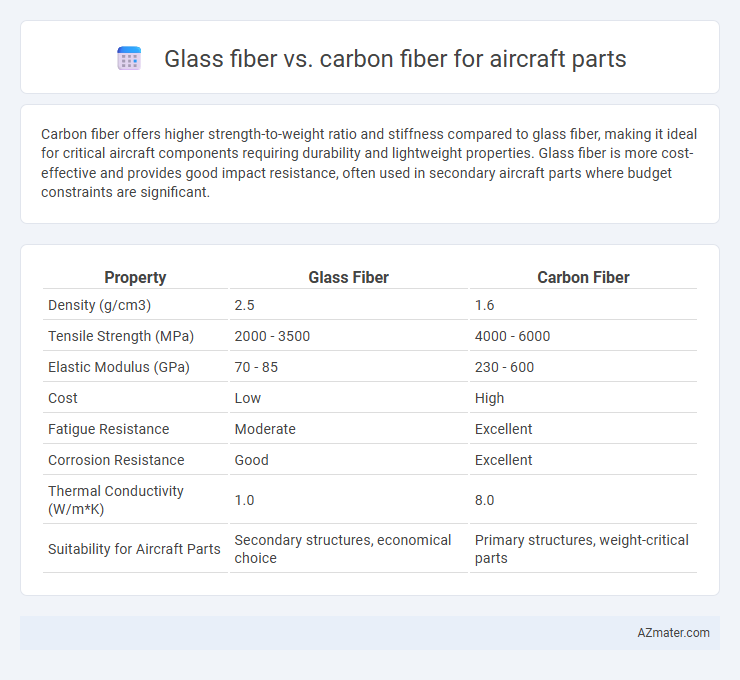Carbon fiber offers higher strength-to-weight ratio and stiffness compared to glass fiber, making it ideal for critical aircraft components requiring durability and lightweight properties. Glass fiber is more cost-effective and provides good impact resistance, often used in secondary aircraft parts where budget constraints are significant.
Table of Comparison
| Property | Glass Fiber | Carbon Fiber |
|---|---|---|
| Density (g/cm3) | 2.5 | 1.6 |
| Tensile Strength (MPa) | 2000 - 3500 | 4000 - 6000 |
| Elastic Modulus (GPa) | 70 - 85 | 230 - 600 |
| Cost | Low | High |
| Fatigue Resistance | Moderate | Excellent |
| Corrosion Resistance | Good | Excellent |
| Thermal Conductivity (W/m*K) | 1.0 | 8.0 |
| Suitability for Aircraft Parts | Secondary structures, economical choice | Primary structures, weight-critical parts |
Introduction to Composite Materials in Aviation
Composite materials in aviation combine fibers like glass and carbon with resin matrices to enhance strength-to-weight ratios and corrosion resistance. Glass fiber offers cost-effective durability and good tensile strength, making it suitable for non-critical aircraft components. Carbon fiber provides superior stiffness, high strength, and weight savings, ideal for structural parts where performance and fuel efficiency are critical.
What is Glass Fiber?
Glass fiber is a lightweight, corrosion-resistant material composed of fine strands of silica-based glass woven into fabric or formed into mats, widely used in aircraft parts for its high tensile strength and cost-effectiveness. It offers excellent electrical insulation and impact resistance, making it suitable for non-structural components, interior panels, and fairings in aviation applications. Compared to carbon fiber, glass fiber provides greater flexibility but lower stiffness, impacting its selection based on specific performance requirements in aircraft manufacturing.
What is Carbon Fiber?
Carbon fiber is a high-strength, lightweight material composed of thin strands of carbon atoms bonded in a crystalline formation, providing exceptional tensile strength and stiffness. Compared to glass fiber, carbon fiber delivers superior strength-to-weight ratio and improved fatigue resistance, making it ideal for critical aircraft parts requiring durability and weight reduction. Its advanced mechanical properties contribute to enhanced fuel efficiency and performance in aerospace applications.
Strength-to-Weight Ratio: Glass vs Carbon Fiber
Carbon fiber outperforms glass fiber in strength-to-weight ratio, making it the preferred material for aircraft parts where minimizing weight while maximizing strength is critical. Carbon fiber typically offers tensile strength of around 3,500 MPa with a density of 1.6 g/cm3, whereas glass fiber provides tensile strength near 2,400 MPa but at a higher density of about 2.5 g/cm3. This superior strength-to-weight ratio of carbon fiber enhances aircraft fuel efficiency and structural performance without adding excess weight.
Durability and Fatigue Resistance
Glass fiber offers excellent corrosion resistance and impact toughness, making it durable under harsh environmental conditions for aircraft parts. Carbon fiber, however, surpasses glass fiber in fatigue resistance due to its higher tensile strength and stiffness, providing superior longevity in cyclic loading situations. The choice between glass and carbon fiber depends on the specific performance requirements and cost considerations of the aircraft component.
Cost Comparison
Glass fiber offers a significantly lower cost compared to carbon fiber, making it a budget-friendly choice for aircraft parts where high strength-to-weight ratio is less critical. Carbon fiber commands a higher price due to its superior stiffness, strength, and lightweight properties, resulting in favored use for performance-critical components despite increased material and manufacturing expenses. The cost difference can range from two to five times more for carbon fiber, influencing the selection based on budget constraints and required mechanical performance in aerospace applications.
Production and Manufacturing Differences
Glass fiber for aircraft parts offers cost-effective production with simpler manufacturing processes like filament winding and resin transfer molding, enabling high-volume output with moderate strength-to-weight ratio. Carbon fiber manufacturing involves complex, labor-intensive steps such as autoclave curing and precise lay-up techniques, resulting in superior strength, stiffness, and weight reduction critical for advanced aerospace applications. Differences in curing times, tooling costs, and composite material properties significantly impact production efficiency and final part performance in aerospace manufacturing.
Environmental Impact and Sustainability
Glass fiber exhibits lower energy consumption during production compared to carbon fiber, resulting in a reduced carbon footprint for aircraft parts. Carbon fiber, while stronger and lighter, requires more energy-intensive manufacturing processes and is less recyclable, posing greater environmental challenges. Sustainable aircraft design increasingly favors glass fiber composites for components due to their balance of performance and lower environmental impact.
Common Aircraft Applications
Glass fiber is widely used in aircraft components such as radomes, fairings, and interior panels due to its excellent corrosion resistance, cost-effectiveness, and good impact resistance. Carbon fiber is preferred for structural parts like wings, fuselage frames, and landing gear components because of its superior strength-to-weight ratio and stiffness. Both materials contribute to weight reduction and fuel efficiency, but carbon fiber's higher performance justifies its use in critical load-bearing applications.
Choosing the Right Composite for Aircraft Parts
Glass fiber composites provide excellent impact resistance and cost-effectiveness for aircraft parts, making them ideal for non-structural components and interior panels. Carbon fiber composites offer superior strength-to-weight ratio and stiffness, critical for structural elements and load-bearing applications in aerospace design. Selecting the right composite depends on balancing performance requirements, weight reduction goals, and budget constraints specific to the aircraft's operational profile.

Infographic: Glass fiber vs Carbon fiber for Aircraft part
 azmater.com
azmater.com